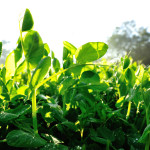 Kenya’s agriculture brings food to the table to 60% of locals who constitute the largest workforce in the country. Yet, due to underutilization, the sector represents just 30% of the country’s Gross Domestic Product. The reason may not be hard to find: despite the highly favorable weather patterns of two seasons of rain yearly, farmers rarely get sufficient enlightening information.
Kenya’s agriculture brings food to the table to 60% of locals who constitute the largest workforce in the country. Yet, due to underutilization, the sector represents just 30% of the country’s Gross Domestic Product. The reason may not be hard to find: despite the highly favorable weather patterns of two seasons of rain yearly, farmers rarely get sufficient enlightening information.
For every intensive farm-related input there is a non-farm effort. This is true in the fresh produce sector of Kenya that is controlled by mainly poor family growers who make 80 percent of the producers. Their non-farm needs range from marketing, retail, information services about crop management and others, all of which need technical assistance. Indeed, agriculture in Kenya requires technological input now more than ever because of advancements in digital information in all related sectors. So, what are some of the measures accruing to technology acquisition in Kenya’s horticulture?
First a context from the most profitable use of technology in world agriculture-the Green Revolution. This refers to the fast rise of agriculture-dependent economies in Asia and the Americas through the injection of technology into their farming. The trend in the ’70s and ’80s saw harvests multiply, especially of grains like rice and maize. The technology of then was scientific and included the use of improved fertilizer, the rise of technologically enhanced seeds and the ability to conserve water even in dry areas. Furthermore, nations like Brazil and China have become flourishing agricultural hubs from the use of biotechnology and the orientation of GPS for managing farming areas.
Secondly, here is an example of a modern technology that has met a breakthrough in India-social farming. Most farmers in the Indian subcontinent were full of doubts in the 1990s with the introduction of new breeds of grains. However, social networking (or the use of technology such as the mobile phone or word of mouth to inform other farmers) led to breakthrough. As more growers learnt from their friends how wonderful the new grains were, the more they adopted the system and alleviated hunger. This same system can happen in the more modern social media such as Facebook and Twitter in Kenya.
Now, here are some measures that highlight the acquisition of technology in Kenya’s horticulture.
The first one and latest is the rise of mobile apps that allow farmers to source information along the supply chain. Through the assistance of the Kenya Agricultural Research Institute (KARI), the use of telephony as a means to disseminate information has spread in the country. Family growers can now have direct linkages with crop scientists, the weather department and vets for shorthand information. For instance, instead of using extension services and radio to learn about the weather patterns, farmers can use certain apps such as M-SHAMBA to get feeds about weekly weather patterns.
The second and directly applicable tech acquisition to Kenya’s farms is biotechnology. One aspect is tissue culture which has come to the rescue of the banana plantations from disease and slow time of productivity. The technology defines the cloning of the tissue of the plant: one such tissue can bear around 2000 suckers ready for transplanting like normal suckers. Their fast maturity of just 11 months as opposed to 14 months for normal ones has made them friendly to many farmers.
The third technology currently in use in Kenya’s horticulture is hydroponic farming. This entails the use of a soil-free culture where plants thrive on a mineral- and nutrient-rich solution. Tomatoes are some of the best cash crops under growth currently as they never lack a market. For a water-hungry crop like the tomato, hydroponic technology solves irrigation bottlenecks as it utilizes just 80% of typical water utility in a farm. As such, hydroponics has become a major source of income for urban dwellers. Due to the shrinking farm area from urbanization, farmers have turned to this less demanding yet high-yielding farming method.
Kenya can borrow a leaf from the main practitioners of hydroponics farming per continent, with the culture media and plants they mainly grow in the following table:
| Country | Crop and Culture Media |
| US | Tomatoes and cucumber on gravel. |
| South Africa | Tomatoes and cucumber on different cultures. |
| UK | Tomatoes, capsicum and cucumber on rockwool. |
| Israel | Different cash crops on a variety of media such as perlite and sand. |
| Brazil | Lettuce and other crops on NFT media. |
Food technology is another critical solution partially being adopted in Kenya. The World Bank predicts in 2018 that in 12 years, Africa will use $1t in food needs alone. It will also import a compounded amount of food based on the 2018 figures of a reigning $50b. So, which technologies have countries like Kenya adopted to forestall food imports in the future? One of the newest initiatives is Digifarm, an initiative under the support of Kenya’s leading telecoms operator, Safaricom. Its aim is to reach the maximum possible number of farmers and guide them on farming practices, marketing and other digital information including storage to alleviate losses. The scheme currently has half a million family growers. This is a slight portion of the 7 million family growers in Kenya. But based on figures that each smallholder farmer supports an average of five persons per family, this could mean a scheme with a wide reach especially as most farmers communicate via mobile.
Bottom-up technology is another system that has come to bear upon Kenya’s agricultural sector. According to the United Nations Framework Convention on Climate Change (UNFCCC), 75% of people in the world subsist on small-scale agriculture for livelihoods. UNFCCC therefore recommends a method where technology is shared between the low-tier farmers and herders in a bottom-up approach.
With this approach, every family grower will be able to use communal technology without having to pay a client for it. Examples in Kenya’s rural areas include the processing of mango chips in Murang’a by women groups. Instead of relying on the mainstream fruit factories at Delmonte in Thika and others, these farmers dry their mangos in charcoal evaporators and kilns and then cut them into slices. They then sell them as mango chips or nutritious mango powder.
In animal agriculture, technology has made a luxury out of a typical cow barn. Unlike recent years, dairy breeds now live a ‘luxury’ lifestyle in sustainable barns free of wet or mud.

Modern herding [Getty Images]
What lacks?
Despite the progress of these online platforms, traditional extension services and mobile phone use, there lacks a centralized information system that is relevant to all farmers. Currently, what one family grower needs is bundled together as a package that may not serve his or her specific needs. Various studies have identified an eAgriculture platform that could combine the most pertinent information challenges of farmers as a solution. Such a platform could then centralize the information repository after a painstaking curation of farmers’ problems. The icing on the cake is the coercion between the various agricultural players such as the government, suppliers and farmers to meet these information needs.
The dependency on extension officers, a case of past farming practices still thrives in many counties. For instance, most of North-Eastern and north Rift herders and farmers still get their information via physical visits by field officers from Nairobi. The majority still rely on broadcasts from the Kenya Broadcasting Corporation (KBC) and other media outlets. To offset the reliance on general content, there is a need for new information avenues that specifically target each farmer or herder at a time.
There is also the challenge of farm capital. Farmers who can afford access to conventional bank credit are a spit in the sand. The rise of informal banking, however, has seen the access to capital by a greater margin than ever before through such platforms as MPESA.
What is being done to alleviate the challenges?
The Food and Agricultural Organization (FAO) in 2017 gave Kenya a high rating among the Sub-Saharan nations wielding the wand of technology. The rating was because of the university drives to support small-scale farmers in the country via farm drives. One such drive, the Farmers Field School has seen many interns enjoin farmers all over their country from the Coast to the Rift Valley. A program in Kilifi in late 2017, for example, saw students and lecturers review the work of farmers for seven days to help them learn how to change their practices outside the classroom. It is such initiatives that will bring new voices of technology from students who blossom into field workers rather than mere theorists.
There are also other sources of credit that have come up including platforms that barter farm produce for credit services. For instance, some firms offer mechanized input and agrochemicals for free and obtain their returns when the farmer sells the produce. These programs are better than those that offer financial credit and expect farmers to pay which they may not afford if they have insufficient harvests. The most sustainable credit providers also choose the kind of plants that are profitable for a given season and provide information to the family growers.
Vision 2030 and KARI’s five-year plan for agriculture, the last of which ended in 2014, are two other ways to help steer agriculture towards a technological course. Under the first plan, Kenya targets a development of 10 percent annually by the year 2030. Under KARI’s plan, the country seeks to indemnify its food basket needs by attracting a 7 percent growth margin in agriculture in each of its five-year calendars.
In summary, the rise of mobile technology for farming and the use of applications in the sector can be outlined into a number of outcomes:
1. Market prices: before technology came to their aid, most small-scale farmers relied on brokers who manipulated prices. Nowadays, the information stream via SMS has allowed farmers to know the actual selling value for their fresh produce.
2. Market knowledge: an example of how market information can empower farmers was the introduction of SMS marketing for Western Kenya’s family growers of passion fruits. This led to 97% of the family growers reporting better revenue than previously.
3. Exchange of information: collaboration has enabled farmers to learn from each other of what to plant and how to manage their crops. They can exchange data from streaming platforms, digital services and extension information. Others form self-help groups for processing their fresh produce.
In short, days are gone when Kenya’s small-scale farmers used to depend on the nearest contacts to the external world-brokers-in order to sell their fresh produce. The coming of technology with free SMS and beneficial apps has brought agriculture to the same tier as other sectors like banking. It has also reduced the dependency on extension officers as access to weather and crop management details are now a tap away on the phone.
References
http://62.24.102.115:8080/xmlui/bitstream/handle/123456789/1210/Awuor_%20Building%20E-Agriculture%20framework%20in%20Kenya.pdf?sequence=1&isAllowed=y
http://ir-library.ku.ac.ke/bitstream/handle/123456789/11628/Farm%20technology%20adoption%20in…..pdf?sequence=1
http://erepository.uonbi.ac.ke/bitstream/handle/11295/99252/Robin%20final%20project.pdf?sequence=1&isAllowed=y
http://ebe.uonbi.ac.ke/sites/default/files/cae/engineering/ebe/Kahehu%20Final%20project.pdf
https://www.standardmedia.co.ke/business/article/2001276881/technology-can-be-used-to-leapfrog-africa-s-agriculture
http://unfccc.int/ttclear/misc_/StaticFiles/gnwoerk_static/TEC_column_L/544babb207e344b88bdd9fec11e6337f/bcc4dc66c35340a08fce34f057e0a1ed.pdf
http://www.farmerstrend.co.ke/how-agriculture-has-changed-with-time-in-kenya/
https://www.researchgate.net/publication/257788782_The_role_of_the_Kenya_Agricultural_Research_Institute_KARI_in_the_attainment_of_household_food_security_in_Kenya_A_policy_and_organizational_review
http://www.adeanet.org/STIforum/en/content/kenya’s-young-digitalize-farming
https://www.nation.co.ke/business/seedsofgold/Kenya-ranked-top-for-agriculture-innovations–/2301238-4211002-87n1vw/index.html
https://www.businessdailyafrica.com/magazines/Mirror-mirror-whos-the-best-agriapps-developer/1248928-1398154-8up5u6z/index.html
https://www.brookings.edu/blog/techtank/2015/04/23/three-ways-mobile-is-helping-farmers-in-kenya/#page-content

